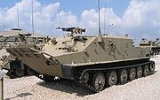
BTR-50
Encyclopedia
The BTR-50
The BTR-50 (BTR stands for Bronetransporter (БТР, Бронетранспортер, literally "armored transporter") is a Soviet amphibious
armored personnel carrier (APC) based on the PT-76
light
tank
. The BTR-50 is tracked, unlike most in the BTR series, which are wheeled. The BTR-50 shares many similarities with two other APCs, the OT-62 TOPAS
and the Type 77. While the OT-62 is an improved copy of the BTR-50 developed jointly by Czechoslovakia and Poland, the Type 77, based on the Type 63 amphibious light tank developed by the People's Republic of China (PRC), is not a copy of the BTR-50.
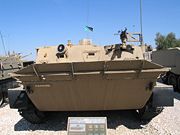
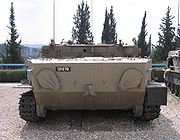 Like the PT-76, the BTR-50 has a flat, boat-shaped hull. Unlike the PT-76, it has a new superstructure added to the front of the vehicle. The hull of the BTR-50 is made of all-welded steel with the crew compartment in the front, the troop compartment in the center and the engine compartment at the rear. It has the ability to transport up to twenty fully equipped infantrymen who sit on benches which run across the full width of the troop compartment. They mount and dismount the APC by climbing over the sides of the hull. The driver sits in the center of the front of the hull and has three vision blocks and periscopes located at the top of the sloping glacis plate. During night operations the center periscope can be swapped for the TVN-28 night vision device which gves the driver clear vision up to 60 meters. The driver also has a small hatch that opens upwards - while it cannot be used to leave the vehicle, it can be opened in relatively safe areas for extra vision. In combat the hatch is closed and the driver can use a vision block. There is an emergency hatch under the driver's seat. The commander, who sits on the left hand side of the front of the vehicle, has three vision blocks and periscopes in a projecting bay and a cupola with a vision block facing forward. It is located on top of the projecting bay, opens forward and can be locked vertically. The vehicle can operate in temperatures between -40 °C and +40 °C.
Like the PT-76, the BTR-50 has a flat, boat-shaped hull. Unlike the PT-76, it has a new superstructure added to the front of the vehicle. The hull of the BTR-50 is made of all-welded steel with the crew compartment in the front, the troop compartment in the center and the engine compartment at the rear. It has the ability to transport up to twenty fully equipped infantrymen who sit on benches which run across the full width of the troop compartment. They mount and dismount the APC by climbing over the sides of the hull. The driver sits in the center of the front of the hull and has three vision blocks and periscopes located at the top of the sloping glacis plate. During night operations the center periscope can be swapped for the TVN-28 night vision device which gves the driver clear vision up to 60 meters. The driver also has a small hatch that opens upwards - while it cannot be used to leave the vehicle, it can be opened in relatively safe areas for extra vision. In combat the hatch is closed and the driver can use a vision block. There is an emergency hatch under the driver's seat. The commander, who sits on the left hand side of the front of the vehicle, has three vision blocks and periscopes in a projecting bay and a cupola with a vision block facing forward. It is located on top of the projecting bay, opens forward and can be locked vertically. The vehicle can operate in temperatures between -40 °C and +40 °C.
The torsion bar suspension consists of six evenly spaced large rubber-tired road wheels with a drive sprocket at the rear and an idler at the front. The road wheels are hollow to assist its amphibious capabilities. These wheels increase the APC's buoyancy by 30%. There are no track-return rollers. The first and last road wheels have a hydraulic shock absorber, the steel tracks have a single pin and 96 links each when new. There is a small, thin, horizontal skirt over each track. The BTR-50 is powered by a V-6 6-cylinder 4-stroke in line water-cooled diesel engine developing 240 hp (179 kW) at 1800 rpm. This gives it a road speed of 44 km/h with a cruising range of 400 km. The vehicle can negoiate 30° side slopes, ascend 60° gradients, cross 1.1 m high vertical obstacles and 2.8 m wide trenches. The engine has a cooling system and a pre-heater (intended for ignition when the air temperature is −20 °C or below). The APC has a 5 gear manual shaft-type transmission system similar to that in the T-34/85 medium tank. The gearbox has four forward and one reverse gear. The vehicle has a side clutch that enables it to make turns, mechanical transmission and a bandbrake. The vehicle has three fuel tanks, two on the right of the front of the engine compartment and one at the rear. All three fuel tanks carry a total of 400 liters. The vehicle has four mounts for additional external fuel tanks at the rear of the hull. The two mounts on the corners of the hull are for a flat external tank, the two mounts in the center of the rear of the hull are for a drum-type of tank.
The BTR-50 is amphibious thanks to its flat, boat-shaped hull which is hermetical and ensures minimal resistance when the APC is afloat. It can swim after switching on the two electric bilge pumps; erecting the trim vane which improves the stability and displacement of the vehicle in the water and prevents water from flooding over the bow of the APC. Swapping the driver's periscope for a swimming periscope enables the driver to see over the trim vane. There is also a manual bilge pump for emergency use. In the water it is propelled by two hydrojets, one on each side of the hull, the inlets are under the hull, the outlets are at the rear. There are also additional assistant water-jet inlets on both sides of the hull over the last road wheels. The rear outlets have lids that can be fully or partially closed, redirecting the water stream to the forward-directed outlets at the sides of the hull, thus enabling the vehicle to turn. This system was designed by N. Konowalow. It is the same system as the one used in the PT-76. The vehicle's low freeboard of 15 to 20 cm and lack of a snorkel means it can only swim in the calmest waters.
Its armor is composed of homogeneous, cold rolled, welded steel - it is very thin by modern standards, 13 mm at the front, 10 mm on the sides and top and 7 mm at the rear. While its maximum armor protects it fully against small arms fire and small artillery shell fragments, it cannot protect it against large shell fragments and .50-caliber machine gun bullets. Although its front armor might protect it against 7.62 mm small arms fire, that same fire can sometimes penetrate the sides. The vehicle is equipped with an IR driving light and an IR searchlight. It lags behind other Soviet armored fighting vehicles because it has no fire or nuclear, biological, chemical (NBC) protection systems, which significantly reduces its effectiveness. The only variant to have a NBC protection system is the BTR-50PK.
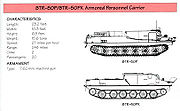 The BTR-50 was developed in 1952 and entered service with the Soviet Army
The BTR-50 was developed in 1952 and entered service with the Soviet Army
in 1954. It was first shown in public in November 1957.It served in the motorized rifle regiments of tank divisions and mechanized brigades in the Soviet and East German armies. A typical mechanized brigade consisted of three battalions which each had thirty APCs and one command vehicle. They were replaced in front line service by the BMP-1
IFV. Command vehicle variants were employed by many Warsaw Pact
armies.
BTR-50s were used by Egypt
and Syria
during the Six-Day War
(1967), a number of which were captured by Israel. Some vehicles were then re-used by the Israeli Army
. Both sides used BTR-50s during the War of Attrition
(1968-1970). During Operation "Raviv" (September 8–9, 1969), an amphibious raid across the Suez Canal, three T-54 tanks and six BTR-50s were used to wreak havoc behind Egyptian lines. BTR-50s were again employed by Egypt, Syria and Israel during the Yom Kippur War
(1973). During this conflict, BTR-50s, along with T-54s and T-55s, were used by the IDF during the fighting in and around the city of Suez
. The Yom Kippur War also witnessed Israel capture additional BTR-50s from the Egyptians and Syrians. Some of Israel's BTR-50s were later transferred to the South Lebanon Army
.
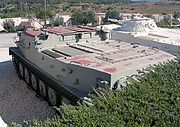
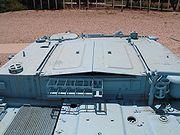
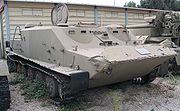
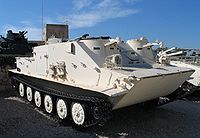
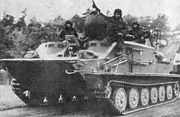
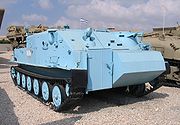
Improvements in firepower are achieved by adding one of two new fighting modules (turrets), both of which are armed with one 30 mm ZTM1 or 2A72 autocannon, one 7.62 mm KT or PKT coaxial machine gun, one 9K113 Konkurs (NATO: AT-5 Spandrel
) ATGM and one 30 mm AGS-17
automatic grenade launcher. Both main guns are stabilized in the vertical axis (the second variant has a two axis stabilization) and have electro-mechanical aiming drives. Both have a maximum effective range of 4,000 m and can be elevated or depressed between −10º and +60º or −4º and +60º. The vehicle carries 150 rounds (the second variant carries 350 rounds).
Both machine guns have a maximum effective range of 1,600 m. The vehicle carries 2000 rounds in four batches of 500, (the second variant carries the same quantity of ammunition but in two batches of 1000 rounds).
The ATGM system has a minimum range of 100 m and maximum range of 4,000 m with four missiles. The automatic grenade launcher has a maximum range of 1,700 m.
Mobility is improved by replacing the Soviet-built engine with the UTD-20 6-cylinder 4-stroke V-type water-cooled diesel engine built in the Ukraine, replacing the gearbox with a planetary system and installing hydraulic volumetric transmission. The suspension has also been improved by adding three return rollers. The vehicle has a new system of air intakes and exhausts on the left hand side of the front of the engine deck. This upgrade can also be applied to BTR-50PU vehicles. This vehicle has a greater combat capability, lower fuel consumption and a higher power-to-weight ratio. The vehicle can operate in temperatures between −40 °C and +55 °C and has an increased road speed of 75 km/h.
As a result of all these changes the vehicle is now higher—3,085 m (the second variant is 2,895 m) and heavier—16.6 tonnes (the second variant weighs 16.8 tonnes).
There are also additional improvements which can be carried out at customer's request. Those include adding kevlar
-type spall liner to improve vehicle's protection, navigation system for improving tactical mobility and air conditioning system for improving crew comfort and allowing easier operation in hot climate.
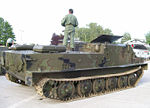 - 100 ordered in 1963 from the Soviet Union and delivered between 1965 and 1966. 560 ordered in 1979 from the Soviet Union and delivered between 1979 and 1988 (the vehicles were previously in Soviet service). - 200 BTR-50s and 150 Type 77s. - 130 BTR-50s ordered in 1977 from the Soviet Union and delivered between 1978 and 1979 (the vehicles were previously in Soviet service). Currently 30 BTR-50s and OT-62 TOPAS
- 100 ordered in 1963 from the Soviet Union and delivered between 1965 and 1966. 560 ordered in 1979 from the Soviet Union and delivered between 1979 and 1988 (the vehicles were previously in Soviet service). - 200 BTR-50s and 150 Type 77s. - 130 BTR-50s ordered in 1977 from the Soviet Union and delivered between 1978 and 1979 (the vehicles were previously in Soviet service). Currently 30 BTR-50s and OT-62 TOPAS
es are in service. - 92 were ordered in 1975 from the Soviet Union and delivered in 1975 (the vehicles were previously in Soviet service). - - 26 BTR-50Ps and BTR-50PKs captured from JNA
, they are planned to be soon replaced by Patria AMV. 18 in service as of 1991 and 2003. - 500 were ordered in 1964 from the Soviet Union and delivered between 1965 and 1966 (the vehicles were possibly previously in Soviet service). 250 BTR-50PKs are currently in service. 100 were upgraded to BTR-50PKM standard. - 31 ordered in 1969 from the Soviet Union and delivered between 1969 and 1970. Used BTR-50PK but withdrew them from service. 70 BTR-50PUM1s and BTR-50YVIs are currently in service. - 10 were ordered in 1981 from the Soviet Union and delivered in 1982 (the vehicles were second-hand). - 150 were ordered in 1959 from the Soviet Union and delivered in 1960. 20 BTR-50PU-IIs are currently in service. - 200 ordered in 1977 from the Soviet Union and delivered between 1978 and 1979. - 66 BTR-50PKs were ordered in 1963 from the Soviet Union and 64 delivered between 1963 and 1965. 34 BTR-50PKs were ordered in 1997 from Ukraine and delivered between 1997 and 1999 (the vehicles were previously in Soviet and later Ukrainian service). Currently 190 are in service. - 270 were ordered in 1966 from the Soviet Union along with 300 BTR-60Ps as a 110$ deal and delivered between 1967 and 1968. 300 BTR-50s and BTR-60s in service as of 2000, 2002, 2005 and 2008. 150 BTR-50s are currently in service. - 300 BTR-50s and BTR-60s in service as of 2000, 2002 and 2005. - 36 were ordered in 1969 from the Soviet Union and delivered in 1970. 60 were ordered in 1977 from the Soviet Union and delivered in 1978 (the vehicles were probably previously in Soviet service). 700 BTR-50s and BTR-60s in service as of 1986. 540 BTR-50s and BTR-60
s are currently in service. - 1 BTR-50PU was ordered in 1982 from the Soviet Union and delivered in 1982. - 50 were ordered in 1966 from the Soviet Union and delivered in 1967. There were 1,010 Korshuns, VTT-323
s, Type 63
s (YW-531), BTR-40
s, BTR-50s, BTR-60
s and BTR-152
s in service as of 1985, 2,200 VTT-323s, Type 63s (YW-531), BTR-40s, BTR-50s, BTR-60s and BTR-152s in service as of 1990 and 1995 and 2,500 VTT-323s, Type 63s (YW-531), BTR-40s, BTR-50s, BTR-60s and BTR-152s in service as of 2000, 2002 and 2005. - - APC withdrawn, 1,000 BTR-50PU, BTR-50PUM, MTP-1 and UR-67 are currently in service. - BTR-50PU - BTR-50PU - 30 were ordered in 1971 from the Soviet Union and delivered in 1973 (the vehicles were previously in Soviet service). - - 50 were ordered in 1968 from the Soviet Union and delivered between 1969 and 1970 (the vehicles were previously in Soviet service). - 150 were ordered in 1966 from the Soviet Union and delivered between 1966 and 1967. 400 were ordered in 1973 from the Soviet Union and delivered between 1973 and 1975 (the vehicles were possibly previously in Soviet service). Around 1,500 BTR-40s, BTR-50s, BTR-60s, BTR-152
s and OT-64s in service as of 1990, 1995 and 2000 and around 1,600 as of 2001, 2003 and 2005. - BTR-50PK based ARVs. - - 40 bought from Syria in 1984.
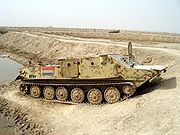 - 700 ordered in 1959 from the Soviet Union and delivered between 1960 and 1963. Withdrawn from service. - 200 SPW-50Ps and SPW-50PKs were ordered in 1958 from the Soviet Union and delivered between 1959 and 1962 (including command vehicles). Passed on to the unified German state. - Taken from GDR's army. All were scrapped or sold to other countries. Iraq
- 700 ordered in 1959 from the Soviet Union and delivered between 1960 and 1963. Withdrawn from service. - 200 SPW-50Ps and SPW-50PKs were ordered in 1958 from the Soviet Union and delivered between 1959 and 1962 (including command vehicles). Passed on to the unified German state. - Taken from GDR's army. All were scrapped or sold to other countries. Iraq
- 250 ordered in 1968 from the Soviet Union and delivered between 1969 and 1973. All destroyed or scrapped. - Captured a number of BTR-50 APCs from Egypt and Syria during the Six-Day War. A number was modified and served with the Israeli Army. Withdrawn from service in 2002. - 20 were received as aid from Israel between 1985 and 1986 (the vehicles were previously in Israeli service). - Passed on to successor states. - 400 were received as aid from the Soviet Union between 1969 and 1973 (some of the vehicles were possibly previously in Soviet service). Passed on to the unified Vietnam state. - 100 were ordered in 1972 from the Soviet Union and delivered in 1973 (the vehicles were previously in Soviet service). - 120 were ordered in 1964 from the Soviet Union and delivered in 1965. Passed on to successor states.
The BTR-50 (BTR stands for Bronetransporter (БТР, Бронетранспортер, literally "armored transporter") is a Soviet amphibious
Amphibious vehicle
An amphibious vehicle , is a vehicle or craft, that is a means of transport, viable on land as well as on water – just like an amphibian....
armored personnel carrier (APC) based on the PT-76
PT-76
The PT-76 is a Soviet amphibious light tank which was introduced in the early 1950s and soon became the standard reconnaissance tank of the Soviet Army and the other Warsaw Pact armed forces. It was widely exported to other friendly states, like India, Iraq, North Korea and North Vietnam. Overall,...
light
Light tank
A light tank is a tank variant initially designed for rapid movement, and now primarily employed in low-intensity conflict. Early light tanks were generally armed and armored similar to an armored car, but used tracks in order to provide better cross-country mobility.The light tank was a major...
tank
Tank
A tank is a tracked, armoured fighting vehicle designed for front-line combat which combines operational mobility, tactical offensive, and defensive capabilities...
. The BTR-50 is tracked, unlike most in the BTR series, which are wheeled. The BTR-50 shares many similarities with two other APCs, the OT-62 TOPAS
OT-62 TOPAS
The OT-62 TOPAS is a series of amphibious tracked armoured personnel carriers developed jointly by Poland and Czechoslovakia . OT-62 stands for Obrněný Transportér vzor 62 – "armoured personnel carrier model 62"...
and the Type 77. While the OT-62 is an improved copy of the BTR-50 developed jointly by Czechoslovakia and Poland, the Type 77, based on the Type 63 amphibious light tank developed by the People's Republic of China (PRC), is not a copy of the BTR-50.
Description


The torsion bar suspension consists of six evenly spaced large rubber-tired road wheels with a drive sprocket at the rear and an idler at the front. The road wheels are hollow to assist its amphibious capabilities. These wheels increase the APC's buoyancy by 30%. There are no track-return rollers. The first and last road wheels have a hydraulic shock absorber, the steel tracks have a single pin and 96 links each when new. There is a small, thin, horizontal skirt over each track. The BTR-50 is powered by a V-6 6-cylinder 4-stroke in line water-cooled diesel engine developing 240 hp (179 kW) at 1800 rpm. This gives it a road speed of 44 km/h with a cruising range of 400 km. The vehicle can negoiate 30° side slopes, ascend 60° gradients, cross 1.1 m high vertical obstacles and 2.8 m wide trenches. The engine has a cooling system and a pre-heater (intended for ignition when the air temperature is −20 °C or below). The APC has a 5 gear manual shaft-type transmission system similar to that in the T-34/85 medium tank. The gearbox has four forward and one reverse gear. The vehicle has a side clutch that enables it to make turns, mechanical transmission and a bandbrake. The vehicle has three fuel tanks, two on the right of the front of the engine compartment and one at the rear. All three fuel tanks carry a total of 400 liters. The vehicle has four mounts for additional external fuel tanks at the rear of the hull. The two mounts on the corners of the hull are for a flat external tank, the two mounts in the center of the rear of the hull are for a drum-type of tank.
The BTR-50 is amphibious thanks to its flat, boat-shaped hull which is hermetical and ensures minimal resistance when the APC is afloat. It can swim after switching on the two electric bilge pumps; erecting the trim vane which improves the stability and displacement of the vehicle in the water and prevents water from flooding over the bow of the APC. Swapping the driver's periscope for a swimming periscope enables the driver to see over the trim vane. There is also a manual bilge pump for emergency use. In the water it is propelled by two hydrojets, one on each side of the hull, the inlets are under the hull, the outlets are at the rear. There are also additional assistant water-jet inlets on both sides of the hull over the last road wheels. The rear outlets have lids that can be fully or partially closed, redirecting the water stream to the forward-directed outlets at the sides of the hull, thus enabling the vehicle to turn. This system was designed by N. Konowalow. It is the same system as the one used in the PT-76. The vehicle's low freeboard of 15 to 20 cm and lack of a snorkel means it can only swim in the calmest waters.
Its armor is composed of homogeneous, cold rolled, welded steel - it is very thin by modern standards, 13 mm at the front, 10 mm on the sides and top and 7 mm at the rear. While its maximum armor protects it fully against small arms fire and small artillery shell fragments, it cannot protect it against large shell fragments and .50-caliber machine gun bullets. Although its front armor might protect it against 7.62 mm small arms fire, that same fire can sometimes penetrate the sides. The vehicle is equipped with an IR driving light and an IR searchlight. It lags behind other Soviet armored fighting vehicles because it has no fire or nuclear, biological, chemical (NBC) protection systems, which significantly reduces its effectiveness. The only variant to have a NBC protection system is the BTR-50PK.
Service history

Soviet Army
The Soviet Army is the name given to the main part of the Armed Forces of the Soviet Union between 1946 and 1992. Previously, it had been known as the Red Army. Informally, Армия referred to all the MOD armed forces, except, in some cases, the Soviet Navy.This article covers the Soviet Ground...
in 1954. It was first shown in public in November 1957.It served in the motorized rifle regiments of tank divisions and mechanized brigades in the Soviet and East German armies. A typical mechanized brigade consisted of three battalions which each had thirty APCs and one command vehicle. They were replaced in front line service by the BMP-1
BMP-1
The BMP-1 is a Soviet amphibious tracked infantry fighting vehicle. BMP stands for Boyevaya Mashina Pekhoty 1 , meaning "infantry fighting vehicle". The BMP-1 was the world's first mass-produced infantry fighting vehicle...
IFV. Command vehicle variants were employed by many Warsaw Pact
Warsaw Pact
The Warsaw Treaty Organization of Friendship, Cooperation, and Mutual Assistance , or more commonly referred to as the Warsaw Pact, was a mutual defense treaty subscribed to by eight communist states in Eastern Europe...
armies.
BTR-50s were used by Egypt
Egypt
Egypt , officially the Arab Republic of Egypt, Arabic: , is a country mainly in North Africa, with the Sinai Peninsula forming a land bridge in Southwest Asia. Egypt is thus a transcontinental country, and a major power in Africa, the Mediterranean Basin, the Middle East and the Muslim world...
and Syria
Syria
Syria , officially the Syrian Arab Republic , is a country in Western Asia, bordering Lebanon and the Mediterranean Sea to the West, Turkey to the north, Iraq to the east, Jordan to the south, and Israel to the southwest....
during the Six-Day War
Six-Day War
The Six-Day War , also known as the June War, 1967 Arab-Israeli War, or Third Arab-Israeli War, was fought between June 5 and 10, 1967, by Israel and the neighboring states of Egypt , Jordan, and Syria...
(1967), a number of which were captured by Israel. Some vehicles were then re-used by the Israeli Army
Israel Defense Forces
The Israel Defense Forces , commonly known in Israel by the Hebrew acronym Tzahal , are the military forces of the State of Israel. They consist of the ground forces, air force and navy. It is the sole military wing of the Israeli security forces, and has no civilian jurisdiction within Israel...
. Both sides used BTR-50s during the War of Attrition
War of Attrition
The international community and both countries attempted to find a diplomatic solution to the conflict. The Jarring Mission of the United Nations was supposed to ensure that the terms of UN Security Council Resolution 242 would be observed, but by late 1970 it was clear that this mission had been...
(1968-1970). During Operation "Raviv" (September 8–9, 1969), an amphibious raid across the Suez Canal, three T-54 tanks and six BTR-50s were used to wreak havoc behind Egyptian lines. BTR-50s were again employed by Egypt, Syria and Israel during the Yom Kippur War
Yom Kippur War
The Yom Kippur War, Ramadan War or October War , also known as the 1973 Arab-Israeli War and the Fourth Arab-Israeli War, was fought from October 6 to 25, 1973, between Israel and a coalition of Arab states led by Egypt and Syria...
(1973). During this conflict, BTR-50s, along with T-54s and T-55s, were used by the IDF during the fighting in and around the city of Suez
Suez
Suez is a seaport city in north-eastern Egypt, located on the north coast of the Gulf of Suez , near the southern terminus of the Suez Canal, having the same boundaries as Suez governorate. It has three harbors, Adabya, Ain Sokhna and Port Tawfiq, and extensive port facilities...
. The Yom Kippur War also witnessed Israel capture additional BTR-50s from the Egyptians and Syrians. Some of Israel's BTR-50s were later transferred to the South Lebanon Army
South Lebanon Army
The South Lebanon Army , also "South Lebanese Army," was a Lebanese militia during the Lebanese Civil War. After 1979, the militia operated in southern Lebanon under the authority of Saad Haddad's Government of Free Lebanon...
.
former USSR



- BTR-50P (Ob'yekt 750) (1952) - The first production version with an open troop compartment. The vehicle had no integral armament but it did have a pintle mount for a 7.62 mm SGMB medium machine gun. Early production BTR-50P models had folding ramps at the rear of the hull to enable either a 57 mm ZiS-2ZiS-2The ZiS-2 was a Soviet 57-mm anti-tank gun used during World War II. The ZiS-4 was a version of the gun meant to be installed in tanks. ZiS stands for Zavod imeni Stalina , the official title of Artillery Factory No...
, a 76.2 mm ZiS-3ZiS-3The 76-mm divisional gun M1942 was a Soviet 76.2 mm divisional field gun used during World War II. ZiS was a factory designation and stood for Zavod imeni Stalina , the honorific title of Artillery Factory No...
or a 85 mm D-4485 mm divisional gun D-44The 85-mm divisional gun D-44 was a Soviet divisional 85-mm calibre field artillery gun used after World War II. It was designed as the replacement for the 76 mm divisional gun M1942 . The gun is no longer in front-line service with the Russian Ground Forces, although some 200 of the Chinese Type...
anti-tank gun to be loaded and fired on the engine decks. The weapon could also be fired when the vehicle was afloat, but only when the water-jets were in operation. This system had one great flaw, the muzzle of the gun was usually over the open personnel compartment and as such submitted any occupants to a considerable amount of concussion and fumes. These ramps were absent in later production models.- BTR-50P - Converted into an artillery portee vehicle. This version carried its gun in the crew compartment, thus placing the muzzle of the gun outside the vehicle. While seen mostly carrying the 57 mm ZIS-2ZiS-2The ZiS-2 was a Soviet 57-mm anti-tank gun used during World War II. The ZiS-4 was a version of the gun meant to be installed in tanks. ZiS stands for Zavod imeni Stalina , the official title of Artillery Factory No...
anti-tank gun, there were also two other variants of this vehicle that carried anti-aircraft (AA) weapons.- ZTPU-2 (zenitnaya samokhodnaya ustanovka) - BTR-50P converted into a self propelled anti-aircraft gun (SPAAG), armed with twin ZPU-2 14.5 mm heavy machine guns (1,280 rounds). Prototype.
- ZTPU-4 (zenitnaya samokhodnaya ustanovka) - A BTR-50P converted into a SPAAG armed with quadruple ZPU-4ZPU-4The ZPU-4 is a towed, quadruple-barreled anti-aircraft gun based on the Soviet KPV 14.5 mm machine gun. It entered service with the Soviet Union in 1949 and is used by over 50 countries worldwide...
14.5 mm heavy machine guns (2,560 rounds). Prototype.
- BTR-50P - Converted into a Forward Air Control vehicle with a second superstructure on top of the first.
- BTR-50P - Converted into a NBC reconnaissance vehicle with a second superstructure on top of the first.
- BTR-50P - Has a longer nose section.
- BTR-50PA (Ob'yekt 750M) (1954) - BTR-50P armed with a 14.5 mm KPV heavy machine gunKPV heavy machine gunThe KPV-14.5 heavy machine gun is a Soviet designed 14.5x114mm-caliber heavy machine gun, which first entered service as an infantry weapon in 1949. In the 1960s the infantry version was taken out of production because it was too big and heavy...
on a pintle mount at the front of the troop compartment.- BTR-50PA with its heavy machine gun mounted on the commander's cupola.
- BTR-50PK (Ob'yekt 750K) (K stands for krisha - "roof") (1958) - A BTR-50P fitted with an armored roof, the troops mounting and dismounting the vehicle via two rectangular roof hatches that open to either side. There is also another rectangular roof hatch at the front of the roof. A BTR-50PK armed with a pintle-mounted 7.62 mm SGMB medium machine gun. This variant has an NBC protection system. The vehicle had two ventilators, one at the front of the troop compartment on the right and one at the rear, also on the right. It is likely that these vehicles were mostly upgraded from BTR-50Ps. Another production run of the BTR-50PK had a single firing port on each side of the superstructure. They were rarely seen in use as APCs as the majority consisted of specialized variants such as command vehicles before being replaced by another batch with two firing ports on each side of the superstructure.
- BTR-50PK - Fitted with a locater light in the center of the engine deck. This variant was issued to Soviet marine and assault river crossing units.
- BTR-50PK - Converted into a training vehicle with four cupolas on top of the roof.
- BTR-50PK - Has a longer nose section. Used by marine units.
- UR-67 (ustanovka razminirovaniya) - Mine-clearing vehicle equipped with a UR-67 rocket launcher system which has three launchers firing UZP-67 or UZR-3 tubes filled with explosives. The UZP-67 or UZR-3 are carried in a fabric tube container carried inside the hull. The mine clearing procedure is composed of driving the vehicle to the edge of the minefield and aligning it before the rockets are fired from its elevated launcher at the rear of the vehicle. The rocket tows the line charge, which is secured to the launcher vehicle, across the minefield. The line charge is then positioned by the vehicle crew and detonated to clear any mines in its vicinity. The cleared lane is usually 60 m to 150 m long and 2 m to 5 m wide. The vehicle has a crew of three. Some of the vehicles were based on the BTR-50PK, others were based on the PT-76. They were known in the west as the MTK and MTK-1. Only a small number remain in service, most have been replaced by the UR-77.
- BTR-50PN (1958) - Early command vehicle with 3 radios (including an R-113) and 3 whip antennas. Only a small number were built.
- BTR-50PU (mashina upravleniya) (1959) - Unarmed command vehicle. It carries a crew of 10 and has an armored roof with oval hatches and 4 whip antennas. Most of the BTR-50PUs have two projecting bays on the front of the vehicle (the respective NATO codes are: BTR-50PU(1) and BTR-50PU(2)). The two bays are the same shape, unlike in the OT-62 TOPAS which is very similar in appearance. The vehicle has a total of ten seats of which four are for the commander and his staff, four are for the radio operators and two are for the vehicle's commander and driver. The staff compartment has a collapsible table, a second small table for the commander, two hammocks and three ladders. An emergency escape hatch is provided in the floor of the vehicle and the vehicle has thermal insulation. Specialized equipment consists of KN-2 and KP-2 navigation devices; an AB-1-P/30 1 kW generator (located on the rear engine deck); R-105, R-105U and R-113 VHF radios; a R-112 HF transceiver, a R-311 HF receiver; a collapsible 11 m mast antenna for the R-105U; a light 10 m telescopic mast for the R-112; a R-403BM relay-set; R-120 intercom and a P-193A 10-line field telephone switchboard with six TAI-43 field telephones and four cable reels, each with 600 m of two-wire cable. The navigation system includes a gyro course indicator and course plotter (the former indicates the vehicle's course, the latter plots it on a rectangular co-ordinate system). Some vehicles have different numbers of stowage boxes in different arrangements on the rear engine decks. Some vehicles have a second generator.
- BTR-50PU with a longer nose section.
- BTR-50PU-2 - An improved version with more modern radio equipment, most probably the R-123 and the R-130M. It is externally similar to the BTR-50PU, but has a portable generator located immediately behind the troop compartment.
- BTR-50PUM - A modernised variant, it is equipped with a large AMU telescopic antenna mast and R-123 (3x), R-130, R-326, R-405D and T-218 radios. This model has a square antenna stowage box on the right front side of the hull.
- BTR-50PUM-1 (1972) - latest model with a crew of up to 8 and fitted with the same radios as mounted in the R-145BM (BTR-60BTR-60The BTR-60 is the first vehicle in a series of Soviet eight-wheeled armoured personnel carriers. It was developed in the late 1950s as a replacement for the BTR-152 and was seen first time in public in 1961...
): R-111 (2x), R-123MT, R-124 and R-130M.
- MTP-1 (mashina tekhnicheskoj pomoshchi) - A technical support vehicle with a raised troop compartment and a light crane.
- Polyesye - A civilian version of the MTP-1.
- BTR-50P - Converted into an artillery portee vehicle. This version carried its gun in the crew compartment, thus placing the muzzle of the gun outside the vehicle. While seen mostly carrying the 57 mm ZIS-2
Belarus
- BTR-50PKM - An upgraded BTR-50PK with a UTD-20 engine developing 300 hp (224 kW), new steering and brake systems.
- MTP-300T - Technical support vehicle, fitted with a manipulator, a universal welding machine, towing and lifting gear, a workbench, spare parts etc.
Bulgaria
- R-82 - An improved BTR-50PU command vehicle with different radios and a collapsible AZI frame antenna.

former Czechoslovakia
- OT-62 TOPASOT-62 TOPASThe OT-62 TOPAS is a series of amphibious tracked armoured personnel carriers developed jointly by Poland and Czechoslovakia . OT-62 stands for Obrněný Transportér vzor 62 – "armoured personnel carrier model 62"...
(OT-62 stands for Obrněný Transportér vzor 62 - "Armored Personnel Carrier model 62") ("TOPAS" stands for Transportér Obrněný PÁSový - "Tracked Armored Personnel Carrier") - A series of BTR-50 variants developed jointly by Poland and Czechoslovakia. They are similar to the BTR-50PK but have hatches in the hull sides, a more powerful PV-6 engine giving 300 hp (224 kW) and two projecting bays at the front of the superstructure instead of one like similar looking BTR-50PU (however the bays are different from one another in terms of shape).
former East Germany

- SPW 50P (Schützenpanzerwagen) - Nationale Volks ArmeeNational People's ArmyThe National People’s Army were the armed forces of the German Democratic Republic .The NVA was established in 1956 and disestablished in 1990. There were frequent reports of East German advisors with Communist African countries during the Cold War...
(NVA) designation for the Soviet-produced BTR-50P.- SPW 50PK - NVA designation for the Soviet-produced BTR-50PK. The NVA had a number of locally modified SPWs in service
- SPW 50PK(Akl) (Aufklärung) - Version for reconnaissance units.
- SPW 50PK(D)
- SPW 50PK(B) (Bergefahrzeug) - A BTR-50PK converted into a recovery vehicle. It weighed 14 tonnes and had a crew of two (commander and driver), with seats for four auxiliary personnel. During rescue operations the vehicle can accommodate up to eight personnel. The SPW-50PK(B) is fitted with R-123M and R-124 radios, a rear-mounted coupling for towing, a tow hook, two extra towing cables, two special quick-release shackles, standard shackles and snap hooks, a searchlight, two lifebelts, life jackets, a set of tools, fire extinguishers and four fenders.
- SPW 50PK(BBS) (Batteriebeobachtungsstelle) - Observation vehicle for air defense units.
- SPW 50PK(KM) (Kernmine) - SPW 50PK, equipped with a tool set for combat engineers PGS-5 (Pioniergerätesatz) to locate and retrieve mines.
- SPW 50PK(LA) (Luftabwehr) - Command vehicle for air defense units.
- SPW 50PK(MRF) (Minenräumfahrzeug), also known as Minenräumfahrzeug 50PK (SPW) - A mine-clearing vehicle, equipped with two containers for mine-clearing charges WLWD of Polish design. The containers were loaded onto the roof of the troop compartment via two ramps, welded on the engine deck.
- SPW 50PK(Pi) - Command vehicle for combat engineer (Pioniere) units.
- SPW 50PK(S) - Command and staff vehicle.
- SPW 50PK(UF) (Unterwasserfahrt) - SPW 50PK, equipped with a tool set for combat engineers PGS-4 (Pioniergerätesatz) to prepare river crossings.
- SPW 50PU - NVA designation for the BTR-50PU.
- SPW 50PU(A) - Locally modified version for the commanders of the divisional artillery.
- SPW 50PK - NVA designation for the Soviet-produced BTR-50PK. The NVA had a number of locally modified SPWs in service
Finland
- BTR-50YVI (yhtymän viestijärjestelmä) - BTR-50PK converted into a command and staff vehicle. It is fitted with the YVI-2 digital communication system, a telescopic mast, the NSVT 12.7 mm heavy machine gun and additional armor. Fielded in 1994.
- BTR-50PUM - Upgraded BTR-50PU fitted with the equipment of the R-145BM (BTR-60 variant) and smoke grenade launchers, one NSVT 12.7 mm heavy machine gun and additional armor.
- BTR-50PUM1 - Modernized PUM with western radio sets.
Indonesia
- BTR-50PM (palawa modification) - Version used by the Indonesian marines (Marinir), fitted with AN/VRC-64 and PRC-33 radios instead of the 10-RT, new brake system, FN MAG machine gun instead of the PKT and a Detroit Diesel 6V92T engine instead of the original V-6V.
- Modified BTR-50PM - Upgraded version, developed by the PT PAL Indonesia company in cooperation with PT PindadPT PindadPT. PINDAD is an Indonesian government owned manufacturing industry specializing in military and commercial products. Its activities cover design, development, engineering and fabrication as well as maintenance.- History :...
. This vehicle has a new nose section, a raised rear hull section and a 270 hp engine. It has an empty weight of 12,750 kg and a combat weight of 14,900 kg. Transport capacity is 3 + 14 troops. Photo- PAL-AFV (armoured floating vehicle) - Latest upgrade, also developed by PT PAL and powered by a 300 hp engine. Combat weight is 14,700 kg. A model of the PAL-AFV was displayed at Indo Defence 2008.
- Modified BTR-50PM - Upgraded version, developed by the PT PAL Indonesia company in cooperation with PT Pindad
Iraq
- BTR-50P - Converted into a self propelled anti-aircraft gun (SPAAG) and armed with a Soviet 23 mm ZU-23-2ZU-23-2The ZU-23-2, also known as ZU-23, is a Soviet towed 23 mm anti-aircraft twin-barreled autocannon. ZU stands for Zenitnaya Ustanovka - anti-aircraft mount.-Development history:...
anti-aircraft autocanon. Fitted with additional armor around the engine decks to maintain its amphibious ability. - BTR-50PK converted into a SPAAG armed with Czechoslovak twin 30 mm M-53/59M53/59 PragaThe M53/59 Praga is a Czechoslovak self-propelled anti-aircraft gun developed in the late 1950s. It consists of a heavily modified Praga V3S 6 wheel drive truck chassis, armed with a twin 30 mm AA autocannon mounted on the rear for which the vehicle typically carries 900 rounds of ammunition, each...
autocannons in an open-tub mount.
Israel
- BTR-50PK fitted with a pintle-mounted US 7.62 mm M60 machine gunM60 machine gunThe M60 is a family of American general-purpose machine guns firing 7.62×51mm NATO cartridges from a disintegrating belt of M13 links...
in front of the commander's copula. - BTR-50PK armed with three pintle-mounted US M1919A4 .30 cal medium machine guns (one on the front of the superstructure and one on each side), another was pintle-mounted in front of the commander's copula.
Poland
- OT-62 TOPASOT-62 TOPASThe OT-62 TOPAS is a series of amphibious tracked armoured personnel carriers developed jointly by Poland and Czechoslovakia . OT-62 stands for Obrněný Transportér vzor 62 – "armoured personnel carrier model 62"...
(OT-62 stands for Obrněný Transportér vzor 62 - "Armored Personnel Carrier model 62") ("TOPAS" stands for Transportér Obrněný PÁSový - "Tracked Armored Personnel Carrier") - A series of BTR-50 variants developed jointly by Poland and Czechoslovakia. They are similar to the BTR-50PK but have hatches in the hull sides, a more powerful PV-6 engine giving 300 hp (224 kW) and two projecting bays in front of the superstructure instead of one like similar looking BTR-50PU (however the bays are different from one another in terms of shape).
Serbia
- BTR-50S (2005) - An upgrade package for the BTR-50PK offered by the Serbian defense firm Yugoimport SPDR. The package adds a turret (from the Yugoslav M-80BVP M-80The BVP M-80, is a Yugoslavian infantry fighting vehicle, produced in the 1980s until the Yugoslav civil wars in the 1990s.-Development:Early research and development of the M-80 began in 1969, with testing of the first completed prototype in 1974. First examples of the, BVP M-80 rolled out in 1979...
APC). It is armed with one 30 mm cannon, one 7.62 mm Zastava M86 machine gun, two ATGM launchers capable of firing 9M14 Malyutka anti-tank guided missiles (ATGM)s and four smoke grenade launchers.
South Lebanon
- BTR-50PK - Converted into an improvised medevacMEDEVACMedical evacuation, often termed Medevac or Medivac, is the timely and efficient movement and en route care provided by medical personnel to the wounded being evacuated from the battlefield or to injured patients being evacuated from the scene of an accident to receiving medical facilities using...
vehicle with a cut down front and a hatch in the front.
Ukraine

- BTR-50PK based ARV.
- BTR-50M - BTR-50PK upgrade built by Morozow. It features improvements in firepower and mobility, both of which can be carried out independently.
Improvements in firepower are achieved by adding one of two new fighting modules (turrets), both of which are armed with one 30 mm ZTM1 or 2A72 autocannon, one 7.62 mm KT or PKT coaxial machine gun, one 9K113 Konkurs (NATO: AT-5 Spandrel
AT-5 Spandrel
The 9M113 Konkurs SACLOS wire-guided Anti-tank missile of the Soviet Union. "9M113" is the GRAU designation of the missile. Its NATO reporting name is AT-5 Spandrel.-Development:...
) ATGM and one 30 mm AGS-17
AGS-17
The AGS-17 Plamya is a Soviet-designed automatic grenade launcher currently in production in the Russian Federation and in service worldwide.-Description:...
automatic grenade launcher. Both main guns are stabilized in the vertical axis (the second variant has a two axis stabilization) and have electro-mechanical aiming drives. Both have a maximum effective range of 4,000 m and can be elevated or depressed between −10º and +60º or −4º and +60º. The vehicle carries 150 rounds (the second variant carries 350 rounds).
Both machine guns have a maximum effective range of 1,600 m. The vehicle carries 2000 rounds in four batches of 500, (the second variant carries the same quantity of ammunition but in two batches of 1000 rounds).
The ATGM system has a minimum range of 100 m and maximum range of 4,000 m with four missiles. The automatic grenade launcher has a maximum range of 1,700 m.
- The vehicle uses a number of instruments with its armament. These include the TKN-5 day/night sight with a laser rangefinder, the PZU-7 day sight for firing at air and ground targets and the 9Sh119M1 anti-tank guided missile system sight.
Mobility is improved by replacing the Soviet-built engine with the UTD-20 6-cylinder 4-stroke V-type water-cooled diesel engine built in the Ukraine, replacing the gearbox with a planetary system and installing hydraulic volumetric transmission. The suspension has also been improved by adding three return rollers. The vehicle has a new system of air intakes and exhausts on the left hand side of the front of the engine deck. This upgrade can also be applied to BTR-50PU vehicles. This vehicle has a greater combat capability, lower fuel consumption and a higher power-to-weight ratio. The vehicle can operate in temperatures between −40 °C and +55 °C and has an increased road speed of 75 km/h.
As a result of all these changes the vehicle is now higher—3,085 m (the second variant is 2,895 m) and heavier—16.6 tonnes (the second variant weighs 16.8 tonnes).
There are also additional improvements which can be carried out at customer's request. Those include adding kevlar
Kevlar
Kevlar is the registered trademark for a para-aramid synthetic fiber, related to other aramids such as Nomex and Technora. Developed at DuPont in 1965, this high strength material was first commercially used in the early 1970s as a replacement for steel in racing tires...
-type spall liner to improve vehicle's protection, navigation system for improving tactical mobility and air conditioning system for improving crew comfort and allowing easier operation in hot climate.
Operators

OT-62 TOPAS
The OT-62 TOPAS is a series of amphibious tracked armoured personnel carriers developed jointly by Poland and Czechoslovakia . OT-62 stands for Obrněný Transportér vzor 62 – "armoured personnel carrier model 62"...
es are in service. - 92 were ordered in 1975 from the Soviet Union and delivered in 1975 (the vehicles were previously in Soviet service). - - 26 BTR-50Ps and BTR-50PKs captured from JNA
Yugoslav People's Army
The Yugoslav People's Army , also referred to as the Yugoslav National Army , was the military of the Socialist Federal Republic of Yugoslavia.-Origins:The origins of the JNA can...
, they are planned to be soon replaced by Patria AMV. 18 in service as of 1991 and 2003. - 500 were ordered in 1964 from the Soviet Union and delivered between 1965 and 1966 (the vehicles were possibly previously in Soviet service). 250 BTR-50PKs are currently in service. 100 were upgraded to BTR-50PKM standard. - 31 ordered in 1969 from the Soviet Union and delivered between 1969 and 1970. Used BTR-50PK but withdrew them from service. 70 BTR-50PUM1s and BTR-50YVIs are currently in service. - 10 were ordered in 1981 from the Soviet Union and delivered in 1982 (the vehicles were second-hand). - 150 were ordered in 1959 from the Soviet Union and delivered in 1960. 20 BTR-50PU-IIs are currently in service. - 200 ordered in 1977 from the Soviet Union and delivered between 1978 and 1979. - 66 BTR-50PKs were ordered in 1963 from the Soviet Union and 64 delivered between 1963 and 1965. 34 BTR-50PKs were ordered in 1997 from Ukraine and delivered between 1997 and 1999 (the vehicles were previously in Soviet and later Ukrainian service). Currently 190 are in service. - 270 were ordered in 1966 from the Soviet Union along with 300 BTR-60Ps as a 110$ deal and delivered between 1967 and 1968. 300 BTR-50s and BTR-60s in service as of 2000, 2002, 2005 and 2008. 150 BTR-50s are currently in service. - 300 BTR-50s and BTR-60s in service as of 2000, 2002 and 2005. - 36 were ordered in 1969 from the Soviet Union and delivered in 1970. 60 were ordered in 1977 from the Soviet Union and delivered in 1978 (the vehicles were probably previously in Soviet service). 700 BTR-50s and BTR-60s in service as of 1986. 540 BTR-50s and BTR-60
BTR-60
The BTR-60 is the first vehicle in a series of Soviet eight-wheeled armoured personnel carriers. It was developed in the late 1950s as a replacement for the BTR-152 and was seen first time in public in 1961...
s are currently in service. - 1 BTR-50PU was ordered in 1982 from the Soviet Union and delivered in 1982. - 50 were ordered in 1966 from the Soviet Union and delivered in 1967. There were 1,010 Korshuns, VTT-323
VTT-323
The North Korean produced M1973 Sinhung VTT-323 is a licensed copy of the Chinese YW 531 Armored Personnel Carrier. The vehicle features a box-like welded steel hull, with a small turret positioned just to the rear of the hull centerline. The VTT-323 has five road wheels and a turret mounting...
s, Type 63
Type 63 (armoured personnel carrier)
The Type 63 is a Chinese armoured personnel carrier that entered service in the late 1960s. It was the first armoured vehicle designed in China without Soviet assistance. The design is simple and is comparable to other APCs of its time such as the M113.Approximately 3,000 were produced by Norinco,...
s (YW-531), BTR-40
BTR-40
The BTR-40 is a Soviet non-amphibious, wheeled armoured personnel carrier and reconnaissance vehicle. It is often referred to as the Sorokovka in Soviet service. It is also the first mass-produced Soviet APC...
s, BTR-50s, BTR-60
BTR-60
The BTR-60 is the first vehicle in a series of Soviet eight-wheeled armoured personnel carriers. It was developed in the late 1950s as a replacement for the BTR-152 and was seen first time in public in 1961...
s and BTR-152
BTR-152
The BTR-152 was a non-amphibious Soviet wheeled armored personnel carrier that entered Soviet service in 1950. By the early 1970s it had been replaced in the infantry vehicle role by the BTR-60...
s in service as of 1985, 2,200 VTT-323s, Type 63s (YW-531), BTR-40s, BTR-50s, BTR-60s and BTR-152s in service as of 1990 and 1995 and 2,500 VTT-323s, Type 63s (YW-531), BTR-40s, BTR-50s, BTR-60s and BTR-152s in service as of 2000, 2002 and 2005. - - APC withdrawn, 1,000 BTR-50PU, BTR-50PUM, MTP-1 and UR-67 are currently in service. - BTR-50PU - BTR-50PU - 30 were ordered in 1971 from the Soviet Union and delivered in 1973 (the vehicles were previously in Soviet service). - - 50 were ordered in 1968 from the Soviet Union and delivered between 1969 and 1970 (the vehicles were previously in Soviet service). - 150 were ordered in 1966 from the Soviet Union and delivered between 1966 and 1967. 400 were ordered in 1973 from the Soviet Union and delivered between 1973 and 1975 (the vehicles were possibly previously in Soviet service). Around 1,500 BTR-40s, BTR-50s, BTR-60s, BTR-152
BTR-152
The BTR-152 was a non-amphibious Soviet wheeled armored personnel carrier that entered Soviet service in 1950. By the early 1970s it had been replaced in the infantry vehicle role by the BTR-60...
s and OT-64s in service as of 1990, 1995 and 2000 and around 1,600 as of 2001, 2003 and 2005. - BTR-50PK based ARVs. - - 40 bought from Syria in 1984.
Former Operators

Iraq
Iraq ; officially the Republic of Iraq is a country in Western Asia spanning most of the northwestern end of the Zagros mountain range, the eastern part of the Syrian Desert and the northern part of the Arabian Desert....
- 250 ordered in 1968 from the Soviet Union and delivered between 1969 and 1973. All destroyed or scrapped. - Captured a number of BTR-50 APCs from Egypt and Syria during the Six-Day War. A number was modified and served with the Israeli Army. Withdrawn from service in 2002. - 20 were received as aid from Israel between 1985 and 1986 (the vehicles were previously in Israeli service). - Passed on to successor states. - 400 were received as aid from the Soviet Union between 1969 and 1973 (some of the vehicles were possibly previously in Soviet service). Passed on to the unified Vietnam state. - 100 were ordered in 1972 from the Soviet Union and delivered in 1973 (the vehicles were previously in Soviet service). - 120 were ordered in 1964 from the Soviet Union and delivered in 1965. Passed on to successor states.

